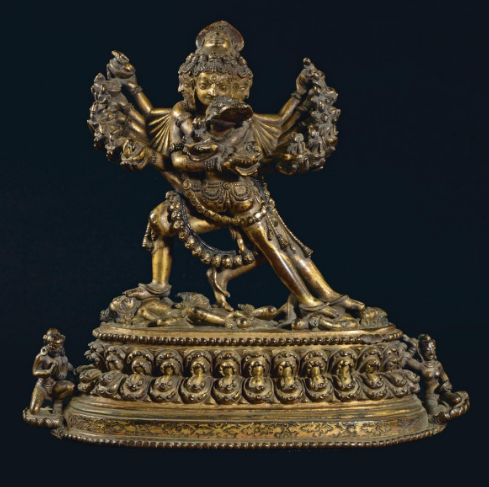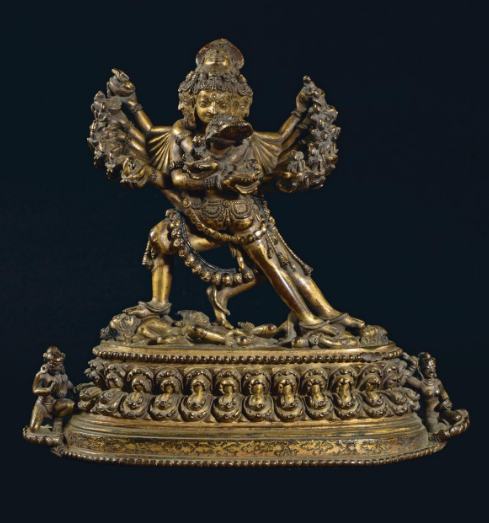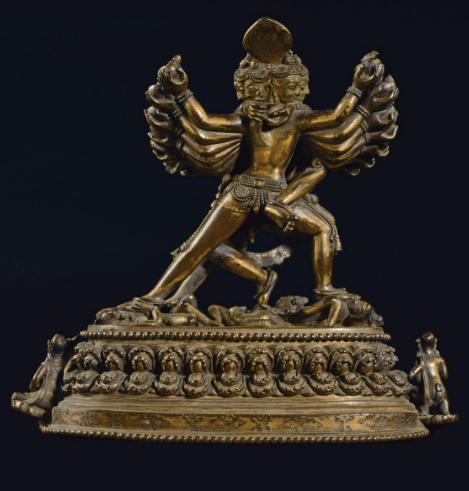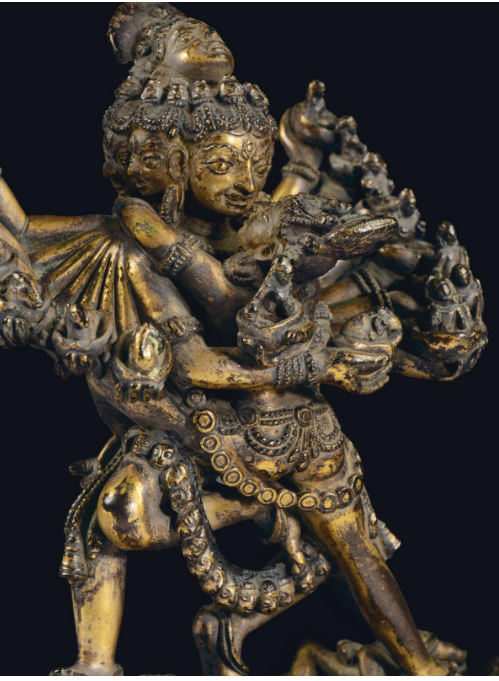Details
- Title : HEVAJRA
- Year : 13th or 14th Century
- Classification : Sculpture
- Medium : Gilt-bronze with applied pigment
- Dimension : Height 6 1/4 in. (15.9 cm.)
- Accession No : GNM_LOT 25_PUN_02
- Country/ Geo-location : Nepal
- Collection : PUNDOLE’S
- Status : LIVE AUCTION The Art of the Himalayas from the Collection of Roshan Sabavala (M0009) (As per NOV 2021)
- ESTIMATED : ₹4,000,000 - ₹6,000,000
- SOLD : ₹26,000,000
- NOTES : Kapaladhara Hevajra in his sixteen-armed form, with eight heads each with a third eye, stands in pratyalidhasana on four prostrate Maras over a double-lotus pedestal. He is joined in yab-yum with his consort Nairatmya, his principal hands crossed behind her back hold kapalas, containing an elephant and a seated deity, his remaining fourteen hands, also hold kapalas, each either containing animals or seated deities. Nairatmya encircles Hevajra's waist with her left leg, her hands holding a vajrakartrika and a further kapala. A male and female donor figure flank the lotus pedestal, each resting on diminutive lotus blossoms, the male figure kneels, his hands clasped in prayer, the female is seated, and holds an offering bowl in her left hand. An entire school of Tantric Buddhist theology developed around the deity Hevajra and his consort. As is usual, the male figure is represented with multiple arms and legs while the female takes a natural human form. With his back legs Hevajra is seen stepping to his right with the right leg bent and the left leg straight, whilst with his front legs he dances in pratyalidhasana. In his eight right hands he holds kapalas containing small effigies of an elephant, a horse, an ass, an ox, a camel, a man, a lion and a buffalo, representing the guardians of the eight directions. The skull cups that he holds in his left hands contain small effigies of deities, namely Prithvi (earth), Varuna (water), Vayu (air), Tejas (fire), Chandra (moon), Aditya or Arka (sun), Yama or Antaka (death) and Dhanada (wealth). In terms of iconography, the current bronze is comparable to the Kapaladhara Hevajra from the Potala Collection identified in Schroeder as no. 102D-E, except that in that instance Hevajra steps to the left (alidhasana) rather than to the right. Furthermore, the final animal representing the directions in the Schroeder bronze is identified as a cat not a buffalo. Compare a 14th century Nepalese Nairatmya in the Shelley and Donald Rubin Collection, see Rob Linrothe and Jeff Watt, Demonic Divine, New York, 2004, pp. 205-06, cat. no. 45. The Rubin bronze has been under worship in Nepal and is consequently well worn from ritual handling, with the loss of much of the sculpture's finer definition. The Sabavala Hevajra, in contrast, is in virtually pristine condition. The bronze may have travelled early on to Tibet, where ritual use does not involve the handling of images, unlike in Nepal. Indeed the faces and hair are painted according to Tibetan ritual practice, confirming its use in Tibet. Although itinerant Newar artists worked in Tibet, the Kathmandu Valley origin of the Sabavala Hevajra is evident from the male and female donor figures kneeling at either end of the elegant lotus pedestal. Bronzes made in Tibet, even when done by Newar artists, do not include depictions of donors. Further indication of its Nepalese provenance is that the lotus base is cast separately from the figures, a common trait of early Kathmandu Valley bronze sculpture. It is likely that the local donors depicted on the base commissioned the statue for use in the Kathmandu Valley during the 13th or at the latest in the early 14th century, and that it was taken fairly shortly thereafter to Tibet, judging by the lack of ritual wear to the gilding. There was a strong bond in the 13th and 14th centuries between the Tibetan Sakya order and Nepal, with Newar artists in demand by the wealthy Sakya monasteries. Hevajra is the principal meditational deity of the Sakyapa, to whom the Sabavala Hevajra would have been a treasure. Through Sakya dominance in the Yuan dynasty (1271 - 1368), Nepalese artists were introduced to the Imperial Chinese court, where they controlled artistic production under the young Newar prodigy Aniko (1245 - 1306). Newar influence continued in the early Ming dynasty (1368 - 1644) as seen in a spectacular Yongle mark and period (1403 - 1424) gilt-bronze Hevajra from the Speelman Collection, see Sotheby's, Hong Kong, October 7, 2006, lot 814.



